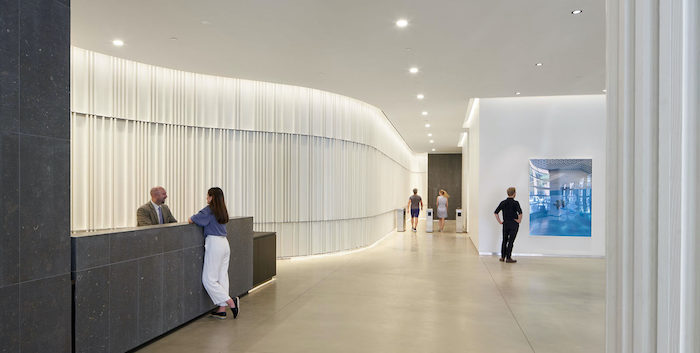
Detta blogginlägg finns endast på engelska.
Perhaps never before has the focus on healthy buildings been as topic as now. The global climate situation, pandemics and the fact that 90% of most people spend their time awake indoors urge the architect society to design sustainable and healthy buildings.

The green building society including green building councils around the world and International WELL Building Institute have urged governments, companies and organizations to design and build sustainable buildings both from a human and environmental perspective. The era we are in right now, urge for healthy buildings supporting human wellbeing. The architectural society has made this as one of the priorities. As the architecture firm HOK expresses it :”a new Architecture of Well-Being”.
The relevance of WELL Building Institutes’ evidence based solutions for designing healthy indoor environments have nowadays increased. The WELL Building Standard is the premier standard for buildings, interior spaces and communities seeking to implement, validate and measure features that support and advance human health and well-being.
Two of the concepts within the standard are Mind, where one of the features is Biophilic Design, and Light where one of the features are Circadian lighting design.
Buildings designed with the Biophilic Design in mind will have elements in the design such as natural light, which is one of the important natural elements in indoor environments to create well-being. As shown in research natural light increases the workplace wellness, health and productivity. This is also the top one boost for the circadian rhythm.

In several articles nowadays it is described how the architectural society links the importance of architecture and well-being, for example in the article Building Health:The Link Between Architecture and Well-Being and the article Redesigning The Office For The Next 100-Year Flu (Yes, It’s Coming).
An article in CNBC states that biophilic design has been embraced by companies who sees the health benefits of bringing the natural elements indoors – it increases wellbeing of employees in regards to health and productivity.
The architectural firm HOK focus on six principles in their work with wellbeing in architecture, “Six fundamental principles drive our integrated design approach for the Architecture of Wellbeing: Accessing Nature, Movement, Nutrition, Air Quality, Decentralization and Trust. The principles begin by addressing the health of individuals and then scale up to focus on the health of the city.” One of them, “accessing nature”, is based in the biophilic design.
Already in 2017 Jake Wayne, leader of the lighting group at Arup’s Boston office, stated in an article of WELL Building Standard after the office had achieved the WELL Certification at the Gold level: “Over the last few years in lighting design, we have learned the importance that light has on human health. Research, in combination with project work, has led us to identify the impact that quality of light can have on quality of life.”
Another beautiful project is the New York based architectural firm CookFox’ project “512 West 22nd Street” – an office building which uses the concept of biophilic design. “Designed to achieve LEED Gold certification and foster an office environment connected with the natural world, 512 West 22nd Street sets new standards of health and productivity in the modern workplace”.

Image courtesy CookFox / Bruce Damonte
We embrace the priorities going on right now within the architectural society. Healthy buildings, for the sake of the people and the environment, should be high on the agenda.
Spreading sunlight in the building
Parans lead sunlight deep into buildings and far away from windows. With the use of highly intelligent technology, we make sunlight an indoor experience. As common as it is to have windows along the facade and that way bring in the natural light, as common it could be to have daylight via a Parans system deeper into the building.
Want to know more about the value of the Parans system? Download our Light Guide.